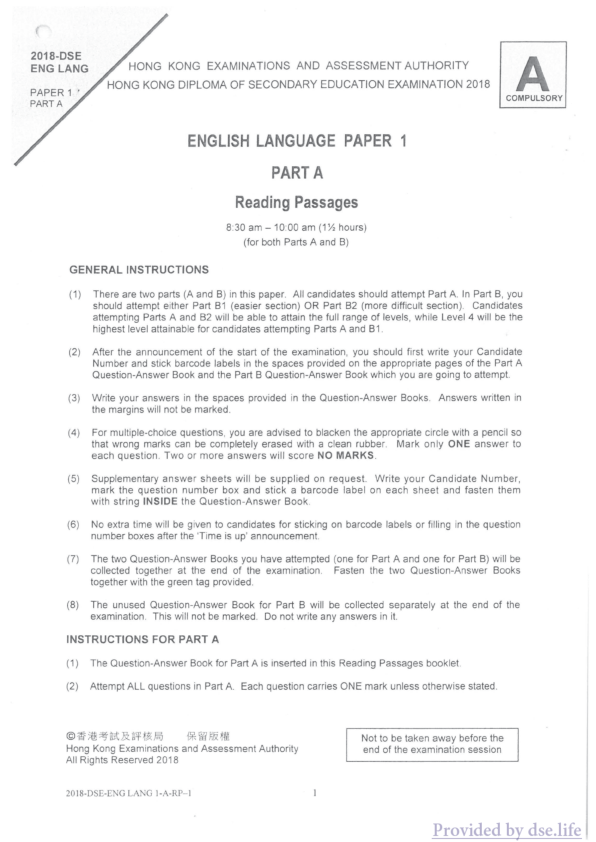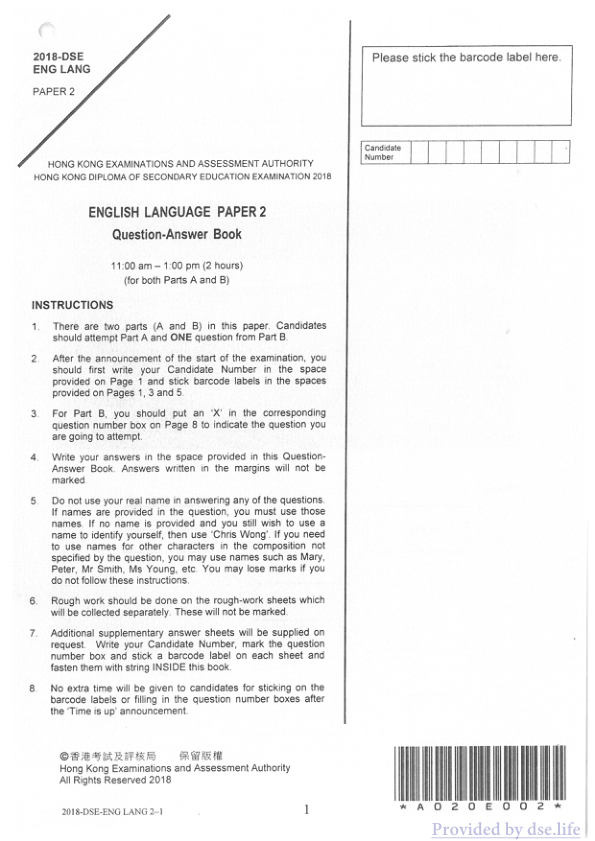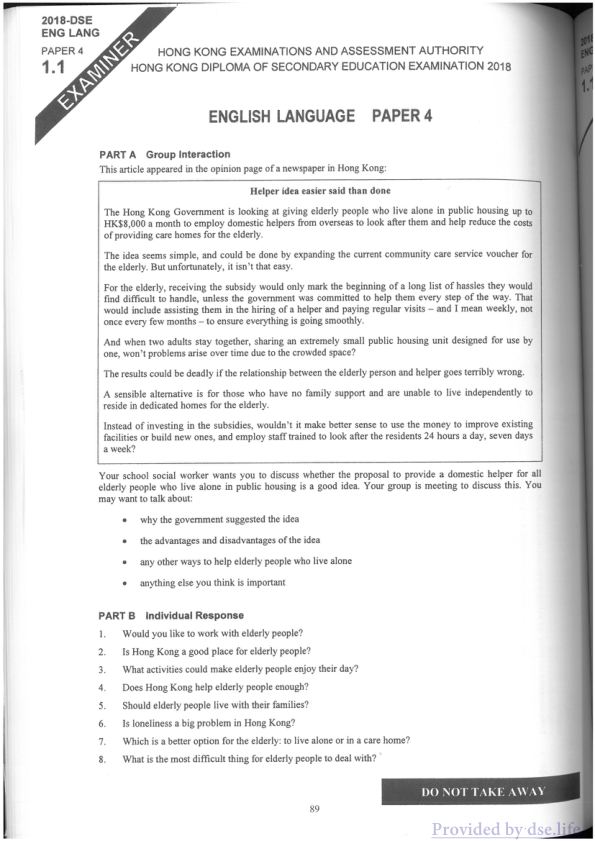2018 DSE 英国语文-English 真题 答案 详解
2018-05-01 dse dse 英国语文-English
| 序号 | 文件列表 | 说明 | ||
|---|---|---|---|---|
| 1 | 2018-英国语文-English-answer.pdf | 13 页 | 4.03MB | 答案 |
| 2 | 2018-英国语文-English-paper1.pdf | 26 页 | 24.55MB | 真题 Paper 1 |
| 3 | 2018-英国语文-English-paper2.pdf | 12 页 | 5.41MB | 真题 Paper 2 |
| 4 | 2018-英国语文-English-paper3.pdf | 42 页 | 16.63MB | 真题 Paper 3 |
| 5 | 2018-英国语文-English-paper4.pdf | 24 页 | 8.82MB | 真题 Paper 4 |
答案
MARKING SCHEMES
The document was prepared as a set of markers for teachers who were not involved in the marking process are advised to ignore its content with care.
Paper 1 (Reading)
Part A (complementary section)
- complimentary [65]
- coach [77]
- Add 1 [70]
- Add 2 [55]
- A [92]
- D [73]
- B [34]
- C [41]
- significant / hard/ challenging / problematic [61]
- slower / lower [42]
- important / vital / crucial [19]
- emotions / senses [31]
- still / always / also [24]
- stimulating / interesting [56]
- stronger / greater [62]
-
(the trouble is) all task in hand // what we are doing [32]
-
imitations i) simplify ii) extenuating / pleasant iii) extracting iv) technology v) balance / simulation vi) game producers use / composers have [60] game players not to focus on the music / focus which doesn't produce music that stays focused to stay focused to the music and distract players from the game [47]
-
compliments A. [58] B. [80] C. [46] D. [89]
- Disagrees [65]
- Disagrees [67]
- Agrees [39]
-
Neither agrees nor disagrees [69]
-
Part B1 (easier section) producing honey / (and) pollinating flowers (to produce fruit) / producing fruit [69]
- C [93] T [35]
- difficult / hard / challenging / problemati c [71] NG [80]
- slower / lower [49]
- immediate [69]
- feed [52]
- pain [64]
- sh unp / burning [40]
- stood on / sat on [37]
- redder / swollen / reddened and swell [84]
- key [45]
- tricky [46]
-
C [43]
-
He may die / many have serious medical conditions [41]
- 3% of the population who see around the string not to squeeze the string see poison / more poison into the wound [72]
- there is extreme variation in musical preferences / music is really down to personal preference so students may react differently will respond to the music in different ways [57]
- impolites [71]
- whispering / tapping a pen [73]
- musical pieces without words we listen while working / doing a task [9]
Provided by dse.life

真题 Paper 1
2018-DSE ENG LANG PAPER 1 PART A HONG KONG EXAMINATIONS AND ASSESSMENT AUTHORITY HONG KONG DIPLOMA OF SECONDARY EDUCATION EXAMINATION 2018 A COMPULSORY ENGLISH LANGUAGE PAPER 1 PART A Reading Passages 8:30 am - 10:00 am (1½ hours) (for both Parts A and B)
GENERAL INSTRUCTIONS
(1) There are two parts (A and B) in this paper. All candidates should attempt Part A. In Part B, you should attempt either Part B1 (easier section) OR Part B2 (more difficult section). Candidates attempting Parts A and B2 will be able to attain the full range of levels, while Level 4 will be the highest level attainable for candidates attempting Parts A and B1.
(2) After the announcement of the start of the examination, you should first write your Candidate Number and stick barcode labels in the spaces provided on the appropriate pages of the Part A Question-Answer Book and the Part B Question-Answer Book which you are going to attempt.
(3) Write your answers in the spaces provided in the Question-Answer Books. Answers written in the margins will not be marked.
(4) For multiple-choice questions, you are advised to blacken the appropriate circle with a pencil so that wrong marks can be completely erased with a clean rubber. Mark only ONE answer to each question. Two or more answers will score NO MARKS.
(5) Supplementary answer sheets will be supplied on request. Write your Candidate Number, mark the question number box and stick a barcode label on each sheet and fasten them with string INSIDE the Question-Answer Book.
(6) No extra time will be given to candidates for sticking on barcode labels or filling in the question number boxes after the 'Time is up' announcement.
(7) The two Question-Answer Books you have attempted (one for Part A and one for Part B) will be collected together at the end of the examination. Fasten the two Question-Answer Books together with the green tag provided.
(8) The unused Question-Answer Book for Part B will be collected separately at the end of the examination. This will not be marked. Do not write any answers in it.
INSTRUCTIONS FOR PART A
(1) The Question-Answer Book for Part A is inserted in this Reading Passages booklet.
(2) Attempt ALL questions in Part A. Each question carries ONE mark unless otherwise stated.
© Hong Kong Examinations and Assessment Authority All Rights Reserved 2018 Not to be taken away before the end of the examination session 2018-DSE-ENG LANG 1-A-RP-1 Provided by dse.life

真题 Paper 2
2018-DSE ENG LANG PAPER 2
HONG KONG EXAMINATIONS AND ASSESSMENT AUTHORITY HONG KONG DIPLOMA OF SECONDARY EDUCATION EXAMINATION 2018
ENGLISH LANGUAGE PAPER 2 Question-Answer Book
11:00 am - 1:00 pm (2 hours) (for both Parts A and B)
INSTRUCTIONS
-
There are two parts (A and B) in this paper. Candidates should attempt Part A and ONE question from Part B.
-
After the announcement of the start of the examination, you should first write your Candidate Number in the space provided on Page 1 and stick barcode labels in the spaces provided on Pages 1, 3 and 5.
-
For Part B, you should put an 'X' in the corresponding question number box on Page 8 to indicate the question you are going to attempt.
-
Write your answers in the space provided in this Question-Answer Book. Answers written in the margins will not be marked.
-
Do not use your real name in answering any of the questions. If names are provided in the question, you must use those names. If no name is provided and you still wish to use a name to identify yourself, then use ‘Chris Wong’. If you need to use names for other characters in the composition not specified by the question, you may use names such as Mary, Peter, Mr Smith, Ms Young, etc. You may lose marks if you do not follow these instructions.
-
Rough work should be done on the rough-work sheets which will be collected separately. These will not be marked.
-
Additional supplementary answer sheets will be supplied on request. Write your Candidate Number, mark the question number box and stick a barcode label on each sheet and fasten them with string INSIDE this book.
-
No extra time will be given to candidates for sticking on the barcode labels or filling in the question number boxes after the ‘Time is up’ announcement.
© Hong Kong Examinations and Assessment Authority All Rights Reserved 2018
2018-DSE-ENG LANG 2-1
Please stick the barcode label here.
Candidate Number
AO20E002
Provided by dse.life

真题 Paper 3
2018-DSE ENG LANG PAPER 3 PART A
A COMPULSORY
HONG KONG EXAMINATIONS AND ASSESSMENT AUTHORITY HONG KONG DIPLOMA OF SECONDARY EDUCATION EXAMINATION 2018
ENGLISH LANGUAGE PAPER 3 PART A Question-Answer Book
GENERAL INSTRUCTIONS
(1) There are two parts (A and B) in this paper. All candidates should attempt ALL tasks in Part A. In Part B, you should attempt either Part B1 (easier section) OR Part B2 (more difficult section). Candidates attempting Parts A and B2 will be able to attain the full range of levels, while Level 4 will be the highest level attainable for candidates attempting Parts A and B1.
(2) Write your Candidate Number and stick barcode labels in the spaces provided on the appropriate pages of Part A Question-Answer Book and both Part B Question-Answer Books.
(3) Write your answers clearly and neatly in the spaces provided in the Question-Answer Books. Answers written in the margins will not be marked. You are advised to use a pencil for Part A.
(4) All listening materials will be played ONCE only.
(5) Supplementary answer sheets will be supplied on request. Write your Candidate Number, mark the question number box and stick a barcode label on each sheet and fasten them with string INSIDE the Question-Answer Book.
(6) The rough-work sheets provided are for you to take notes. They will be collected separately and will not be marked.
(7) No extra time will be given to candidates for sticking on the barcode labels or filling in the question number boxes after the 'Time is up' announcement.
(8) The two Question-Answer Books attempted by candidates (one for Part A and one for Part B) will be collected together at the end of the examination. Fasten the two Question-Answer Books together with the green tag provided.
(9) The other unused Question-Answer Book for Part B will be collected separately at the end of the examination. This will not be marked. Do not write any answers in it.
© Hong Kong Examinations and Assessment Authority All Rights Reserved 2018
2018-DSE-ENG LANG 3-A-1
Please stick the barcode label here.
Candidate Number
A020E03A
Provided by dse.life

真题 Paper 4
2018-DSE ENG LANG PAPER 4 EXAMINER HONG KONG EXAMINATIONS AND ASSESSMENT AUTHORITY HONG KONG DIPLOMA OF SECONDARY EDUCATION EXAMINATION 2018 ENGLISH LANGUAGE PAPER 4 PART A Group Interaction This article appeared in the opinion page of a newspaper in Hong Kong: Helper idea easier said than done The Hong Kong Government is looking at giving elderly people who live alone in public housing up to HK$8,000 a month to employ domestic helpers from overseas to look after them and help reduce the costs of providing care homes for the elderly. The idea seems simple, and could be done by expanding the current community care service voucher for the elderly. But unfortunately, it isn’t that easy. For the elderly, receiving the subsidy would only mark the beginning of a long list of hassles they would find difficult to handle, unless the government was committed to help them every step of the way. That would include assisting them in the hiring of a helper and paying regular visits – and I mean weekly, not once every few months – to ensure everything is going smoothly. And when two adults stay together, sharing an extremely small public housing unit designed for use by one, won’t problems arise over time due to the crowded space? The results could be deadly if the relationship between the elderly person and helper goes terribly wrong. A sensible alternative is for those who have no family support and are unable to live independently to reside in dedicated homes for the elderly. Instead of investing in the subsidies, wouldn’t it make better sense to use the money to improve existing facilities or build new ones, and employ staff trained to look after the residents 24 hours a day, seven days a week? Your school social worker wants you to discuss whether the proposal to provide a domestic helper for all elderly people who live alone in public housing is a good idea. Your group is meeting to discuss this. You may want to talk about: why the government suggested the idea the advantages and disadvantages of the idea any other ways to help elderly people who live alone anything else you think is important PART B Individual Response 1. Would you like to work with elderly people? 2. Is Hong Kong a good place for elderly people? 3. What activities could make elderly people enjoy their day? 4. Does Hong Kong help elderly people enough? 5. Should elderly people live with their families? 6. Is loneliness a big problem in Hong Kong? 7. Which is a better option for the elderly: to live alone or in a care home? 8. What is the most difficult thing for elderly people to deal with? DO NOT TAKE AWAY 89 Provided by dse.life

